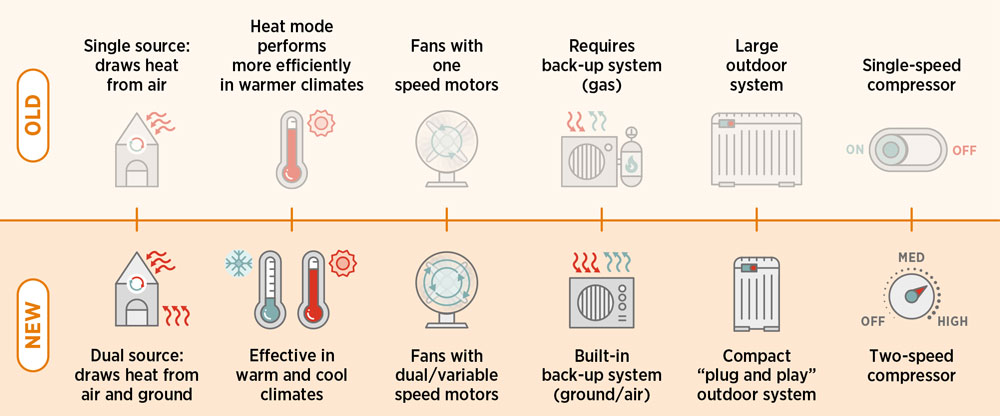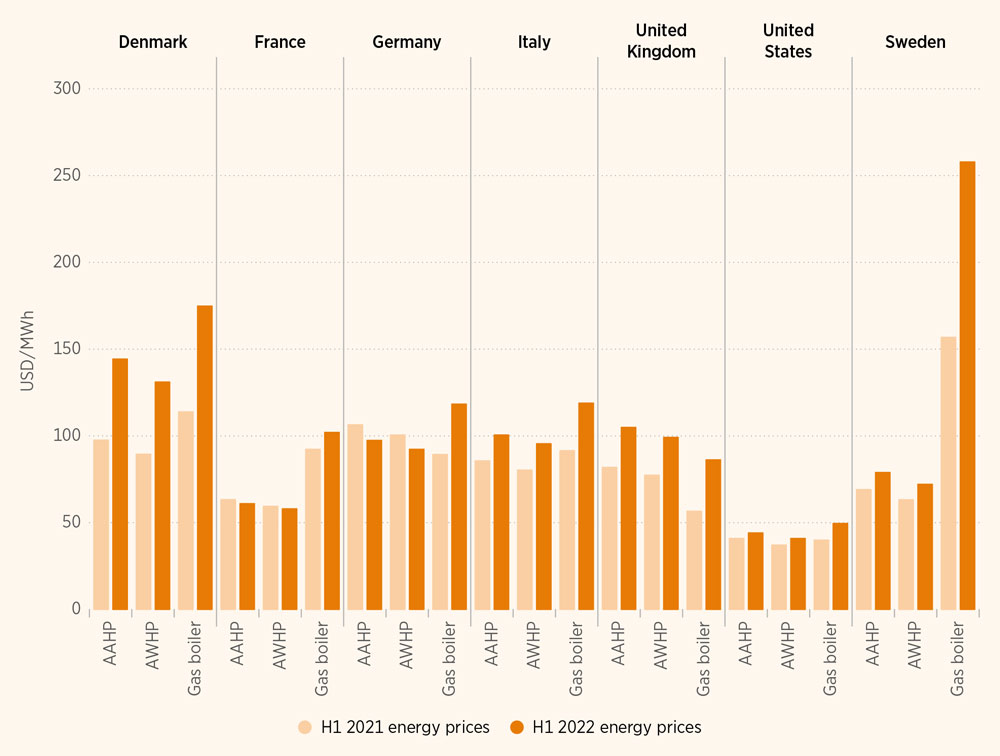Low-temperature heat pumps
Overview of the status and impact of the innovation

What
Electrically-driven heat pumps are the most promising technology for the electrification of the heating and cooling sector. They efficiently transfer thermal energy from many different possible sources, including outdoor air, underground heat, water or waste heat from industry sewage treatment to indoor spaces or processes where the heat is needed. Heat pumps are already a mature technology for efficiently supplying heat at temperatures up to 100°C (even from ambient air with temperatures below 0°C as a source). They also now exclusively use refrigerants that do not deplete the ozone layer; refrigerants with high global warming potential are being phased out. 8
Heat pump technology is also advancing rapidly (Figure 6.2). New innovations include:
FIGURE 6.2 Advances in heat pump technology

- Increased efficiency through use of more than one source, for example, air and ground.
- Increased ability to produce heat efficiently and economically in cold weather (the central goal of the US Department of Energy’s “Cold Climate Heat Pump Technology Challenge”).
- Built-in backup systems that allow switching to another source of heat or cooling (e.g. ground instead of air) rather than relying on backup systems using fossil fuels.
- Compact plug-and-play systems, which are simpler and can be installed inexpensively.
- Dual- or variable-speed compressors to increase efficiency, reduce noise and enable more control for demand-response services.
- More efficient and silent fan designs.
- Improved integration into buildings’ energy systems and more control of the balance between heat pump and backup system operation (thus allowing monovalent or monoenergetic operation) (McSurdy, 2019).
Why
Low-temperature heat pumps are the most important technology for decarbonising 9 heating and cooling end uses. They also offer major improvements in the overall energy efficiency of the buildings sector.
BOX 6.1 The economics of heat pumps
Heat pumps have been used most often in countries with comparatively low electricity prices, such as Sweden, which has large amounts of hydro and nuclear power. Elsewhere, heat pump adoption has, until recently, been hindered by lack of awareness and confidence, and by the perception of higher upfront investment costs compared with fossil fuel–based alternatives as well as the misperception that heat pumps cannot deliver comfortable levels of heat for residential use in cold-weather climates.
In fact, in countries like Sweden or Denmark, heat pumps are already cost competitive with their biggest competitor, gas-condensing boilers. In other countries, such as the United Kingdom, heat pumps are slightly costlier. Figure 6.3 shows the marginal costs of air-to-air heat pumps, air-to-water heat pumps and gas boilers for selected countries.
Recently, heat pumps have become much more economically attractive due to the European energy crisis, and soaring gas prices. If gas prices were to remain as high as they were in 2022, then market conditions would strongly favour heat pumps over gas boilers. The challenge then lies in creating the right incentives to accelerate the shift from gas boilers to heat pumps.
FIGURE 6.3 Marginal cost of heating with residential heat pumps and gas boilers under different energy cost assumptions in selected countries between H1 2021 and H1 2022

Notes: AAHP = air-to-air heat pump; AWHP = air-to-water heat pump; H1 = the first half of the fiscal year; MWh = megawatt hour.
Related kits
Power to heat and cooling innovations
Innovations (35)
-
Technology and infrastructure
- 1 Low-temperature heat pumps
- 2 Hybrid heat pumps
- 3 High-temperature heat pumps
- 4 Waste heat-to-power technologies
- 5 High-temperature electricity-based applications for industry
- 6 Low-temperature thermal energy storage
- 7 Medium- and high-temperature thermal energy storage
- 8 Fourth-generation DHC systems
- 9 Fifth-generation DHC systems
- 10 Internet of Things for smart electrification
- 11 Artificial intelligence for forecasting heating and cooling demands
- 12 Blockchain for enabling transactions
- 13 Digitalisation as a flexibility enabler
-
Market design and regulation
- 14 Dynamic tariffs
- 15 Flexible power purchase agreement
- 16 Flexible power purchase agreement
- 17 Standards and certification for improved predictability of heat pump operation
- 18 Energy efficiency programmes for buildings and industry
- 19 Building codes for power-to-heat solutions
- 20 Streamlining permitting procedures for thermal infrastructure
-
System planning and operation
-
Business models
- 28 Aggregators
- 29 Distributed energy resources for heating and cooling demands
- 30 Heating and cooling as a service
- 31 Waste heat recovery from data centres
- 32 Eco-industrial parks and waste heat recovery from industrial processes
- 33 Circular energy flows in cities – booster heat pumps
- 34 Community-owned district heating and cooling
- 35 Community-owned power-to-heat assets